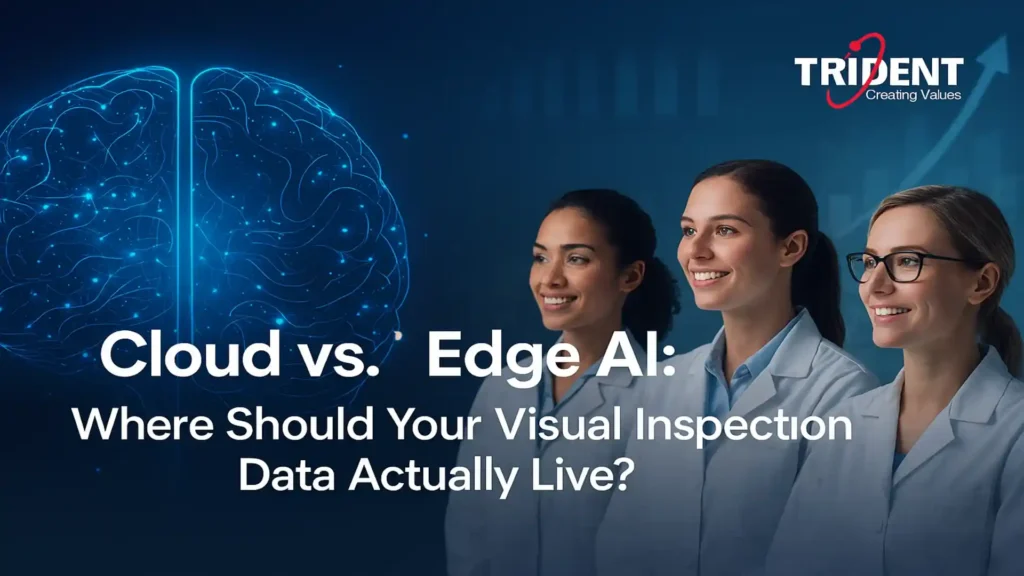Cloud vs. Edge AI: Where Should Your Visual Inspection Data Actually Live?
Introduction to Visual Inspection Data in the Age of AI Visual inspection has quietly become the backbone of modern quality control. From detecting microscopic defects on a pharmaceutical blister pack to spotting cracks in automotive components, visual data decides whether products pass or fail. But here’s the real question most businesses struggle with—where should all this inspection data actually live? With AI stepping into the picture, companies are now choosing between Cloud AI and Edge AI. Think of it like deciding whether to store your valuables in a central bank vault or keep them in a safe right next to you. Both options sound good, but the right choice depends on what you’re protecting and how fast you need access. What Is Visual Inspection Data? Visual inspection data includes images, videos, and metadata captured by cameras, sensors, and machine vision systems. This data is analyzed to detect defects, deviations, or inconsistencies in products or processes. In high-speed production lines, this data is generated continuously and in massive volumes. Because this data directly impacts product quality and compliance, where it is processed and stored matters more than ever. A delay of even milliseconds can mean defective products slipping through the line. Why AI Is Transforming Visual Inspection Traditional rule-based inspection systems were rigid and error-prone. AI-powered visual inspection systems learn patterns, improve over time, and adapt to new defect types. They don’t just “see”; they understand context. AI turns raw visual data into actionable intelligence. But AI models need computing power, fast decision-making, and reliable data access. That’s where the Cloud vs. Edge debate begins. Understanding Cloud AI What Is Cloud AI? Cloud AI refers to AI models and data processing hosted on centralized cloud servers. Visual inspection data is sent from cameras or machines to the cloud, where powerful algorithms analyze it and send results back. How Cloud AI Processes Visual Data In cloud-based setups, images and videos are uploaded to remote servers. These servers run advanced AI models, often using GPUs, to analyze defects, patterns, and trends. Results are stored centrally and accessed by teams across locations. This approach is like sending your raw materials to a massive factory that can process anything—but it’s not always nearby. Key Benefits of Cloud AI Cloud AI shines when it comes to scalability. You can process huge volumes of visual data without worrying about hardware limits. It also makes centralized monitoring easier, especially for multi-plant operations. Another big advantage is advanced analytics. Cloud platforms are ideal for training AI models, running historical analysis, and generating insights that improve long-term quality strategies. Limitations of Cloud AI for Visual Inspection Latency is the biggest concern. Sending data to the cloud and waiting for a response may be too slow for real-time inspection. Even a small delay can disrupt fast-moving production lines. There’s also the issue of data security and compliance. Transmitting sensitive inspection data over networks can raise red flags, especially in regulated industries. Understanding Edge AI What Is Edge AI? Edge AI processes data locally, right where it is generated—on cameras, industrial PCs, or edge devices. Instead of sending images to the cloud, the AI model runs on-site and makes instant decisions. How Edge AI Handles Visual Inspection Data With Edge AI, cameras capture images and immediately analyze them using embedded AI models. Defects are detected in real time, and actions—like rejecting a product—happen instantly. It’s like having a quality expert standing next to every machine, making decisions on the spot. Key Benefits of Edge AI Speed is the biggest win. Edge AI delivers ultra-low latency, making it perfect for real-time inspection. There’s no dependency on internet connectivity, which means fewer disruptions. Edge AI also enhances data security. Since data stays on-site, the risk of exposure is significantly reduced, making compliance easier. Limitations of Edge AI Edge devices have limited computing power compared to cloud servers. This can restrict complex analytics and large-scale AI model training. Managing and updating AI models across multiple edge devices can also be challenging without a centralized strategy. Cloud vs. Edge AI: Core Differences Data Latency and Speed Edge AI wins hands down when milliseconds matter. Real-time defect detection simply works better at the edge. Cloud AI, while powerful, introduces unavoidable delays. If your production line runs at high speed, edge processing isn’t optional—it’s essential. Data Security and Compliance Keeping sensitive visual inspection data on-site reduces compliance risks. Industries like pharmaceuticals and food manufacturing often prefer Edge AI for this reason. Cloud AI can still be secure, but it requires strict governance, encryption, and compliance controls. Scalability and Infrastructure Costs Cloud AI scales effortlessly. You pay for what you use and expand as needed. Edge AI requires upfront investment in hardware and ongoing maintenance. However, edge solutions can reduce long-term data transfer costs, especially with high-volume visual data. Reliability and Downtime Risks Edge AI continues working even if the network goes down. Cloud AI depends on stable connectivity, which can be a single point of failure. For mission-critical inspection, reliability often tips the scale toward edge computing. Where Should Your Visual Inspection Data Live? Real-Time Manufacturing Environments In fast-paced manufacturing, decisions must happen instantly. Edge AI is the clear choice here, ensuring defective products are caught before they move further down the line. Latency is the enemy of quality in such environments. High-Volume, Multi-Site Operations Cloud AI works well when you need centralized visibility across multiple plants. It enables standardization, benchmarking, and performance comparisons at scale. Many global manufacturers rely on cloud platforms for strategic oversight. Regulated Industries Like Pharma and Food Compliance requirements often dictate where data lives. Edge AI helps maintain data sovereignty and reduces audit complexities. Cloud AI still plays a role in reporting and compliance documentation. AI Model Training vs. AI Model Execution A smart approach is training AI models in the cloud and deploying them at the edge. This balances performance with scalability. Think of the cloud as the brain gym and the edge as the athlete in action. The Hybrid Approach:
Cloud vs. Edge AI: Where Should Your Visual Inspection Data Actually Live? Read More »




